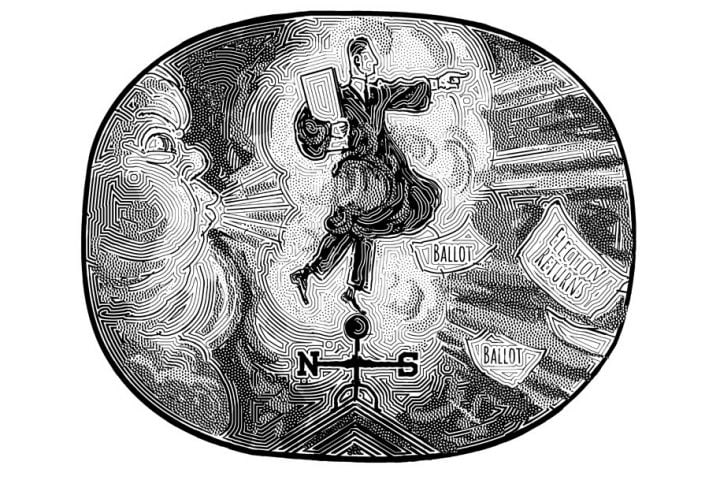Totally facepalm, headdesk, re gg’s Little Women! YOYO if U waste $ on dis STUPID BAD FLIK! SMH!!
There you have it: my one-tweet review of Greta Gerwig’s new film of Little Women, Louisa May Alcott’s beloved novel about four sisters coming of age in Concord, Massachusetts, during the Civil War. Even without running my Twitter-speak through Google Translate, you can probably guess I was annoyed by this film. But according to what passes for a cultural establishment these days, that should make us both feel good, because every time a woman expresses her anger, Progress takes another step forward.
At the risk of confounding Progress, I offer here a step backward, in the form of an old-fashioned essay, thousands of characters long, that disputes nearly every plaudit heaped on this film. In particular, it disputes the praise lavished on the scene in which Marmee, the mother of the four sisters, confesses to her second-oldest daughter, Jo, “I am angry nearly every day of my life.” This line, which comes directly from the novel, is not included in most of the previous screen adaptations, so the critics have been lauding it as a bold stroke on Gerwig’s part, one that brings Little Women to the forefront of the #MeToo era.
A.O. Scott of the New York Times extolled the scene as evidence of the director’s courageous refusal to “minimize or apologize for that anger.” Joe Morgenstern of the Wall Street Journal called it “a revelation that will lead to liberation.” Literary scholar Anne Boyd Rioux, author of a recently published study of Little Women’s cultural legacy, praised the film for including this “anger talk,” because “[w]omen’s anger has been such a taboo topic, and it’s great to see that we are finally getting to the point where we can acknowledge it.”
What I find annoying about these plaudits is their invocation of “women’s anger” as some sort of hidden treasure that the human race is only now discovering, thanks to a 36-year-old filmmaker from California. Even more irksome is their bland assumption that this precious emotion must always find full-throated expression, because it is always righteously directed at injustice. I hate to be a stickler, but “women’s anger” is an exceedingly broad category, covering a myriad of situations. Surely any one instance requires us to ask certain questions, such as: Who is angry? What is she angry about? To whom, and in what manner, is she expressing her anger? And (most important) is her anger justified?
Marmee’s Progress
In a puff piece—I mean, interview—with the Wall Street Journal, Laura Dern, the actress who plays Marmee, gives the cultural establishment’s preferred answer: Marmee is “angry because she’s a radical. She had a lot to say, and the world didn’t give her space.” This answer is not wrong, because the character of Marmee is based on Alcott’s own mother, née Abigail May, a redoubtable figure whose life would have been very different had she been born male. But Dern’s answer is not right, either, because it willfully ignores the larger context in which this scene appears.
That context is Chapter 8 of the novel, entitled “Jo Meets Apollyon.” For the reader who has not dipped into the Book of Revelation recently, Apollyon (“Destroyer”) is a monster archdemon who rules as “the angel of the bottomless pit.” Apollyon is also featured in The Pilgrim’s Progress, John Bunyan’s 1678 allegory about a pilgrim soul named Christian making the arduous journey from the City of Destruction to the Celestial City. Christian meets Apollyon after climbing the Hill of Difficulty, and they fight a long battle in the Valley of Humiliation, at the end of which Christian, dressed in a suit of armor fashioned by God, defeats the monster with the Sword of the Spirit.
A classic of English Puritan literature, The Pilgrim’s Progress was still being read in mid-19th-century Massachusetts. Little Women is full of references to it, and in the case of “Jo Meets Apollyon,” the meaning is clear enough, if you follow the storyline. Unfortunately, this is not easy to do in Gerwig’s Little Women, because of her inexplicable decision to “edit” the film by the digital equivalent of feeding a document into a shredder, then gluing the pieces together in a totally random way. The arty term for this mode of composition is “aleatory,” and I am surprised none of the critics brandished it, given all the other pseudo-sophisticated excuses they made for what is clearly a bad call. Do they really believe, as some suggested, that the gooey dollops of music unceasingly ladled over this mess serve to hold it together?
Gerwig’s “editing” reaches its migraine-inducing climax during the sequence where the film repeatedly cuts back and forth between the childhood bout of scarlet fever that nearly kills one of the four sisters, saintly but sickly Beth, and Beth’s death several years later, from complications caused by the disease. Watching this mind-boggling sequence, even the most attentive moviegoer must be asking silently what someone in the row behind me asked aloud: “What? Is she dying? Didn’t she just get better?”
In Alcott’s novel, by contrast, the storyline—or rather, storylines—are easy to follow. Unlike Jane Austen and George Eliot, with whom she is sometimes compared, Alcott was not a great artist with an acute and profound understanding of the long-term workings of moral principles in human life. Rather she was a middling novelist with a talent for the sort of facile moralizing found in the family sitcoms of the 1950s, where every episode presents a choice between nice and not-so-nice, then resolves it just in time for the final commercial. Alcott does pretty much the same in every one of the 47 chapters that constitute Little Women. This way of writing was very popular at the time, and brought much-needed income to Alcott’s struggling family. But it also stunted her talent, as she understood better than anyone.
To return to Apollyon: Chapter 8 begins with 15-year-old Jo and her older sister Meg dressing up to attend a matinee at the local theater in the company of Laurie, the rich, lovable boy next door. The youngest sister, Amy, begs to go along, because the alternative is to stay home with 13-year-old Beth, who is absorbed in playing nursemaid to several dolls. Meg is inclined to say yes, but Jo won’t hear of it and speaks harshly to Amy before slamming the door on the way out. Lest we miss the point, Alcott then explains that both Jo and Amy “had quick tempers, and were apt to be violent when fairly roused,” adding that, of the two, “Jo had the least self-control.”
Here it is worth noting that in these early chapters, Amy is only 12. This fact has been altered in every screen adaptation I have seen, with the exception of Gillian Armstrong’s 1994 film, which stars 12-year-old Kirsten Dunst as the young Amy, then switches to an older actress later on. This altering of Amy’s age has always posed problems, but Gerwig makes it worse by assigning the role to Florence Pugh, a zaftig 24-year-old who would make a terrific Mae West. This completely changes the scene that follows the older sisters’ departure, in which Amy angrily takes the sole manuscript of Jo’s first literary effort, the product of several months’ work, and throws it into the fire. In a 12-year-old, such a deed is mean, impulsive, and bratty. In a 24-year-old, it is cruel, calculated, and something else beginning with a “b.”
Anger Is Not a Virtue
Such details are of little interest to the critics. According to the normally astute Ann Hornaday, film critic for the Washington Post, Gerwig’s adaptation is “very nearly perfect,” because while it appreciates how the four sisters represent female “archetypes,” it also shows that “those archetypes existed—and still do—within a rigged system.” Thus, Hornaday credits Gerwig with giving Amy “more gravitas than she’s been given in the past,” and offers as evidence the line, added by Gerwig, in which grownup Amy tells Laurie why she intends to marry a rich man she does not love: “Don’t sit there and tell me that marriage isn’t an economic proposition, because it is.” For Hornaday, such added touches make this film “true to its period,” while also paying “homage to female ambitions, appetites, and irrepressible will.”
No, sorry, no. There is no way to be true to the period in which Little Women was written, while also paying homage to the ambitions, appetites, and irrepressible will of any human being, male or female. That would be as daft as paying homage to anger per se. I believe it was Aristotle, one of my favorite dead white males, who distinguished between the emotion of anger, which is neither a virtue nor a vice, and the virtue related to that emotion, which in any given situation is the mean between too much anger and too little. I might also add that Aristotle regarded plot—meaning moral action—as the most important ingredient in drama. So once again, let us consider the storyline.
Alcott describes how, after returning home and discovering that Amy has burned her precious manuscript, Jo’s “hot temper mastered her, and she shook Amy till her teeth chattered in her head, crying, in a passion of grief and anger,—‘You wicked, wicked girl! I can never write it again, and I’ll never forgive you as long as I live!’” Jo is still furious the following day, when she and Laurie decide to go skating on the Concord River before the last ice of winter melts. Amy, who has tried in vain to apologize, runs after them but fails to hear Laurie’s warning to “Keep near the shore; it isn’t safe in the middle.” Because Jo is still “taking a bitter, unhappy sort of satisfaction in her sister’s troubles,” she doesn’t warn Amy either.
Thus abandoned, Amy skates into the middle of the river and immediately falls through the ice. Panic ensues, and it is only with Laurie’s “self-possessed” guidance that Jo manages to help save her sister’s life. Later, when Amy is sleeping by a hot fire, Jo bursts into “a passion of penitent tears,” confessing to Marmee that when “my dreadful temper” takes hold, “I get so savage, I could hurt any one, and enjoy it. I’m afraid I shall do something dreadful some day, and spoil my life, and make everyone hate me. Oh, mother! help me, do help me!”
That is when Marmee confides, “I am angry nearly every day of my life,” and tells Jo about her 40-year struggle “not to show it,” and ultimately “not to feel it.” In the novel—not the film—Marmee concludes by admonishing Jo, “Keep watch over your ‘bosom enemy’ [meaning Apollyon, the “fault” in her soul]…before it brings you greater sorrow and regret than you have known today.” In the vanished world of moralizing sitcoms, this preachy bit was known in the industry as the MOS, short for “moment of shit.” Little Women contains many such moments, but that does not make it a sitcom, because these two central characters possess a depth and complexity that go beyond facile moralizing.
Escaping Vanity Fair
By this standard, Gerwig’s film pales by comparison to the three-part BBC series that aired on PBS’s Masterpiece in spring 2017. That series, directed by Vanessa Caswill and written by Heidi Thomas, is not perfect: the opening scene of the sisters getting dressed is weirdly voyeuristic; Amy is played by yet another zaftig 20-something; and the art director sprays far too much fake snow on the green landscape of Ireland, where the series was filmed. But these flaws are outweighed by huge merits, chief among them the inspired casting of Maya Hawke as Jo, Jonah Hauer-King as Laurie, and most of all, Emily Watson as Marmee. No other actress, least of all Laura Dern, can hold a candle to Watson’s brilliant performance.
As noted above, Marmee was modeled on Alcott’s mother, Abigail May. Born in 1800, Abigail was the child of a pedigreed Boston family who, in keeping with the custom of the time, sent its daughters to primary school only, then kept them at home while their brothers went on to secondary school, followed (in most cases) by Harvard. As it happened, Abigail’s father and favorite brother recognized her abilities and provided her with a hand-me-down version of male education—and in the process ignited a flame of reformist zeal that was very much in keeping with the times.
Some of that zeal came from England, where Mary Wollstonecraft’s A Vindication of the Rights of Woman had appeared in 1792. Based on the proposition that true virtue requires the exercise of reason, Wollstonecraft argued forcefully that female education, as understood by the upper classes of 18th-century England and France, was depriving girls of the chance to become fully developed human beings. Taking aim at the views of female education held by thinkers as profound as Jean-Jacques Rousseau and as shallow as John Gregory (author of a popular tract on the subject), Wollstonecraft insisted that the “whole purport” of these views was “to degrade one half of the human species, and render women pleasing at the expense of every solid virtue.”
This was not—repeat, not—a condemnation of marriage and motherhood. On the contrary, it was a warning that if a young girl is taught nothing but dainty manners, stylish dress, and other “false refinement,” she might be able to lasso a rich husband, but she will not be able to keep him past the expiration date of her sexual allure. Still less will she be able to rear children with a capacity for rational thought, moral judgment, and true friendship.
To read Little Women in this light is to understand the character of Amy, and her older sister Meg, better than any filmmaker has done. Both are beauties: Amy is “[a] regular snow maiden, with blue eyes, and yellow hair curling on her shoulders”; Meg is “very pretty, being plump and fair, with large eyes, plenty of soft brown hair, a sweet mouth, and white hands, of which she was rather vain.” Both are attracted to fancy balls, “pretty things,” and all the other temptations of “Vanity Fair,” the greedy, mercenary place in The Pilgrim’s Progress where “all that is there sold, or that comes thither, is vanity.” And both are courted by small men with big fortunes, until, fortified by the virtues instilled in them by their mother, they escape these snares and make marriages that are worthy of them.
Abigail’s Triumph
In her reading of Rousseau’s Emile, Wollstonecraft grants that “if man did attain a degree of perfection of mind when his body arrived at maturity, it might be proper” that his wife “should rely entirely on his understanding.” But then Wollstonecraft drives home the point: “husbands, as well as their helpmates, are often only overgrown children; nay, thanks to early debauchery, scarcely men in their outward form—and if the blind lead the blind, one need not come from heaven to tell us the consequence.”
If Abigail May did not grasp this point before marrying Bronson Alcott, she grasped it afterward. Bronson, the self-educated son of a Connecticut farmer, was not given to debauchery, except perhaps the intellectual kind peculiar to Transcendentalism at its nuttiest. But he was definitely an overgrown child. And if his wife had been any less endowed with solid virtue, the world might never have heard of Louisa May Alcott, because she and her sisters would likely have died of neglect and starvation.
It is no accident that Little Women begins by placing the family patriarch hundreds of miles away, serving as a chaplain in the Union Army; and when he must come home, obscures his portrait with a thick layer of pious clichés. Greater accuracy would have turned this charming, uplifting novel into a grim, naturalistic saga of horrendous mistakes, failed utopian projects, and pitiful dependency on better men, such as Ralph Waldo Emerson, to rescue the family from grinding poverty.
It is clear from Abigail’s papers that she did rage inwardly, not just at Bronson’s fecklessness, but also at a social milieu that elevated this foolish man’s contempt for earthly existence over his sensible wife’s unceasing toil to maintain that same existence. In a journal entry dated August 26, 1843, she wrote:
A woman may perform the most disinterested duties. She may “die daily” in the cause of truth and righteousness. She lives neglected, dies forgotten. But a man who never performed in his whole life one self-denying act, but who has accidental gifts of genius, is celebrated by his contemporaries, while his name and his works live on, from age to age. He is crowned with laurel, while scarce a “stone may tell where she lies.”
Today, 177 years later, it is good to know that Bronson’s name has not lived on—that indeed, his laurel is quite shriveled, while Abigail’s modest stone is frequently visited in Concord’s Sleepy Hollow Cemetery. But would this be the case if, instead of struggling to control her fiery temper, Abigail had unleashed it on her hapless husband and young children (or posted it on Twitter)?






